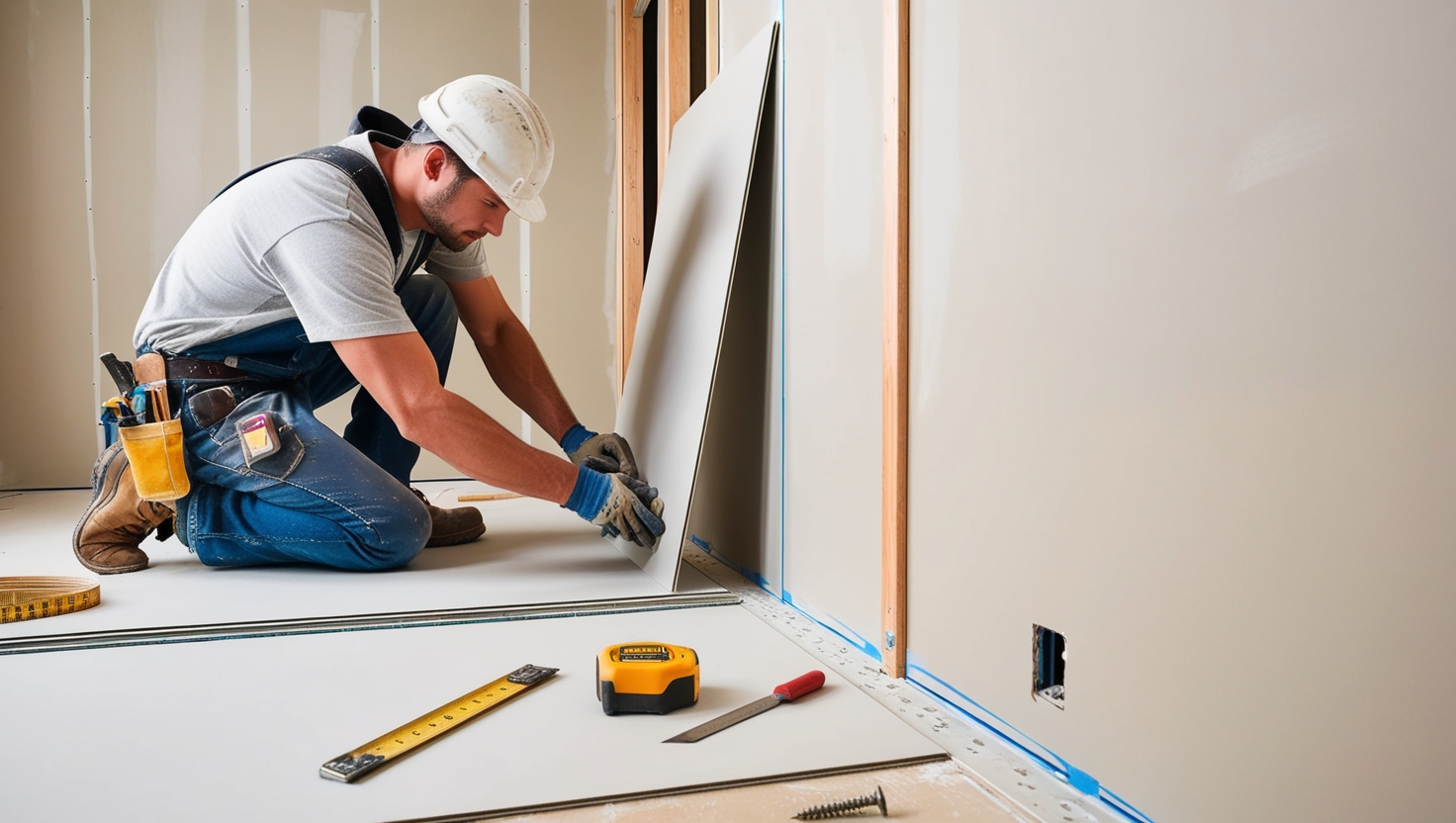How to Install Drywall Anchors: Whether hanging a shelf, mounting a TV, or installing curtain rods, drywall anchors fall into that category of essential tools that provide necessary support, keeping items securely attached to your walls. Without them, heavy objects can easily pull screws right out of drywall and cause damage or unsafe conditions. From the right way of installation to the kinds that are available, this guide will walk you through all you need to know about drywall anchors; from correct installation methodology to the types that are available, and give some tips that ensure your installation is strong and secure.

Understanding Drywall Anchors
Drywall anchors are a device that is inserted into the drywall for holding a screw, mostly used in wall hangings. Logically, it would be obvious that just mere drywall is not strong enough to hold up things directly, especially if you only rely on screws or nails. When you drive a screw into a drywall anchor, it expands or locks into place behind the drywall to create a much stronger hold.
There are numerous types of drywall anchors that serve different weights and purposes. Understanding these types is, in essence, understanding how to install drywall anchors.
Types of Drywall Anchors
Plastic Expansion Anchors
Description: Plastic expansion anchors are the most common drywall anchors. The design is such that when a screw is screwed into it, it expands and tightly holds onto the dry wall.
Best For: Light to medium loads like picture frames, small shelves, and towel racks.
Installation: Easy to install; suitable for various wall types.
Self-Drilling Anchors-Threaded Anchors
Description: Anchors in this type come in a threading design and, hence, do not require a pre-drilled hole. They are screwed right into the drywall and hence convenient and time-saving.
Best For: These anchors will have holding weight capability from medium to heavy and can carry bigger shelves, curtain rods, and even mirrors.
Installation: Easy and simple, holding more weight compared to plastic expansion anchors.
Toggle Bolts
Description: It is a bolt and a couple of wings that fold back as you drive the bolt through the wall. Once on the inside, the wings expand and lock against the backside of the drywall.
Best For: Heavy loads are held by these bolts, such as TVs, large shelves, and ceiling installations.
Installation: Larger pre-drilled hole required and more fiddly installation, yet provides the best hold.
Molly Bolts
Description: These have a sleeve that expands inside the wall once you screw into it creating a tight fit.
Best For: Shelves, cabinets and wall-mounted TV brackets. Medium to heavy weights.
Installation: Requires a pre-drilled hole, but most people would find that skilled installation is necessary for a reliable hold.
Toggle Anchors Snap toggles
Description: Toggle anchors are a lot like toggle bolts but have a metal channel that goes behind the drywall and is clamped in place by a plastic strap.
Best For: Heavy loads and fixtures that need to be securely held to the wall.
Installation: The process is similar to installing toggle bolts but is usually a bit simpler. Removing can often also be easier.
Tools and Materials Needed
Before you start the drywall anchor installation process, here are the tools and materials you may want to have:
Drywall anchors-appropriate to the weight and type of item you’re hanging Screws-usually come with the anchors Drill with drill bits Screwdriver or drill with a screwdriver bit Hammer-for some types of anchors Level-optional, to make sure everything is perfectly placed Pencil-to mark positions Tape measure-for accurate placement Stud finder-optional, to avoid drilling into studs Step-by-Step Instructions for Putting Up Drywall Anchors
Step 1: Choose the Correct Anchor
First things first: learn what type of drywall anchor is right for the job. Consider how heavy the object you are hanging will be and what type of wall you are working with. Generally speaking, plastic expansion anchors will do the trick for light objects-under 20 pounds-while heavier items-over 50 pounds-call for something a little more robust, like toggle bolts or molly bolts.
Step 2: Mark the Spot
Mark the spot with a pencil where you want to place the anchor. If you’re hanging more than one item, such as a series of shelves, make sure the marks are even using a level.
Step 3: Drill a Pilot Hole (if necessary)
Most drywall anchors should be pre-drilled before installation, with a bit that is the size of the anchor. For self-drilling anchors, you would skip this step since they don’t need a pre-drilled hole.
Plastic Expansion Anchors: Use a drill bit a bit smaller than the anchor.
Toggle Bolts & Molly Bolts: Use a drill bit that is the size of the anchor’s folded diameter.
Self-Drilling Anchors: No pilot hole required.
Step 4: Insert the Anchor
Plastic Expansion Anchors:
Slightly hammer the anchor into the hole with a hammer until it is flush to the wall.
Self-Drilling Anchors:
Place the point of the anchor on the mark and screw it into the drywall using a screwdriver or drill until it is flush.
Toggle Bolts:
Fold the wings of the toggle bolt and push them through the hole. On the other side of the wall, the wings spring open. Turn the screw until the toggle pulls up tight against the drywall.
Molly Bolts:
Push the molly bolt into the hole and hammer it flush to the wall. Screw the screw to spread the sleeve behind the drywall.
Toggle Anchors:
Insert the toggle anchor into the hole. Pull the strap until the metal channel is snug against the back of the drywall. Slide the plastic cap tight against the wall and snap off excess strap.
Step 5: Drive Screw
Once this anchor is set, take the screw and pass it through whatever you are hanging and into the anchor. Begin screwing this in until it is snug. Do not overtighten; this can strip the anchor or tear the drywall.
Step 6: Check the Stability
Pull the item lightly after setting the screw to ensure that it does not droop. If loose, check that the anchor has been appropriately set and that the screw is snug.
How to Install Drywall Anchors Successfully
Avoid Studs:
Since the drywall anchor is for use where there are no studs, use a stud finder to determine the locations of studs and avoid them. If you hit a stud, often it is best to screw directly into the stud rather than into the anchor.
Use the Right Drill Bit:
If the drill bit is too large, there will be a sloppy fit; if it is too small, it is hard to get the anchor in. For good results, the size of the drill bit should match the size of the anchor.
Don’t over tighten them:
This may cause the anchor to lose its grip or the drywall might be damaged. Just screw them just enough to hold your item tightly.
Know the weight limits:
Know what the weight limits of your anchors and screws are. Too much, and you might suddenly face failure or even wall damage.
Practice with Scrap Drywall:
If you are starting new with wall drywall anchors, you may want to practice on a piece of scrap before you start drilling into your wall. That could give you a great feel for how the anchors work and further help you avoid mistakes.
Correcting the Common Faults Anchor Won’t Go in Straight:
You probably are hitting an obstruction behind the drywall. Pull the anchor out and start over by drilling a new hole just above or below where you put it in before.
Anchors spin in the wall:
This usually happens if the hole is too large. You may need to try another location or let the compound patch of a wall dry before you could try to anchor it.
Screw Won’t Tighten:
If, for one reason or another, the screw simply will not tighten, this may be because the screw is too short, or the anchor lost its ‘hold’ in the wall. Consider using a longer screw or replacing the anchor with a stronger type.
Drywall Cracks:
If the drywall cracked when installing the anchor, this is sometimes due to over tightening or having the anchor too large. Use a smaller anchor and drill a smaller hole to avoid this.
Conclusion
Installing drywall anchors is a fantastic skill for every handyman or even a homeowner. With the right tools, anchors, and technique, you can hang pretty much anything on the walls without any fear of it falling or causing damage. This step-by-step guide will help you in selecting the right type of anchor and then installing it correctly to achieve a safe and secure installation. Whether you’re hanging a television, a heavy mirror, or just some pictures, drywall anchors are the key to a safe and successful project.
